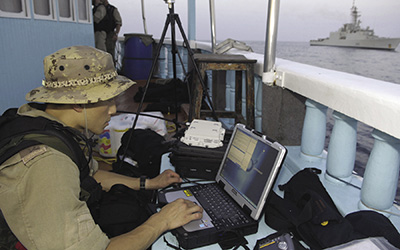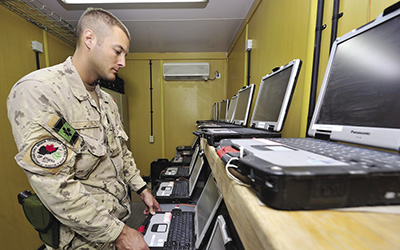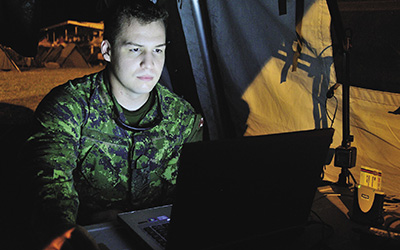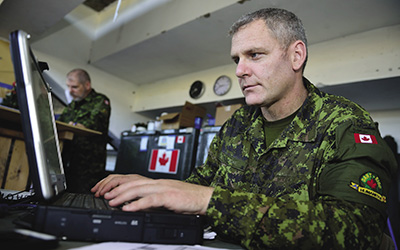VIEWS AND opinions

DND photo IS2008-5527 by Master Corporal Gaetan Racine
Change for the Better – The Canadian Defence Academy, Future Plans, and Moving Forward
by Bill Railer, Phil Hoddinott, and Jason Barr
For more information on accessing this file, please visit our help page.
Introduction
Change can be a good thing, and that is fortunate, because we often hear that change is a constant in life, and this is particularly true with respect to the Canadian Armed Forces (CAF). Within the CAF, the Canadian Defence Academy (CDA) is a change leader—CDA’s Future Plans and Modernization section is specifically tasked with developing innovative techniques—technologies and practices to map the way ahead for Individual Training and Education (IT&E) in the CAF.
The Future Plans and Modernization section has a wide spectrum of initiatives underway, and this brief article addresses two of our most promising examples, the Online Government Advanced Research and Development Environment (ONGARDE), and the Learning Support Centres (LSCs). These initiatives are maturing every day, and they will form integral parts of a consolidated plan to take the CAF to the forefront of IT&E modernization with an integrated, adaptive system of collaborative, innovative, initiatives developed to streamline and rationalize individual training.

Library and Archives Canada PA 130914, Photo by Ken Bell
Humble beginnings, or IT&E Modernization …not! A Canadian Army signalman operates a radio receiver and remote unit in Zeddam, Netherlands, towards the end of the Second World War, 4 April 1945.
ONGARDE – Security Sector Knowledge Network
During the Chief of Defence Staff’s change of command ceremony, Prime Minister Harper stated:
“The Forces must be restructured to ensure administrative burdens are reduced and resources freed up for the front line. The Canada First Defence Strategy must continue to advance, and as I’ve said before, with the constant search for more teeth and less tail. Within very real budgetary constraints, Canada needs to maintain a modern, general purpose, military capability.”
Collaboration platforms, such as GCPedia and GCConnex, open the doors to Government of Canada (GoC) cross collaboration. They cannot, however, meet the unique needs of the security-conscious Federal Security Sector.
As transparency and cost savings become more pervasive throughout the GoC, one recognizes the unique challenge of collecting the widespread activities and success stories related to Training and Education throughout the Security Sector. Specifically, Afghanistan and the 2010 Olympics highlighted the need for increased collaboration across the Federal Security Sector. This was followed by the GoC Strategic Review that mandated the need to ‹do more with less.’
In response to the above, the Future Plans and Modernization section’s Learning Technologies Team partnered with the National Research Council and Defence Research and Development Canada Toronto to develop a solution that would bring secure collaboration and information sharing to the Federal Security Sector.
The intent of ONGARDE is to provide the Federal Security Sector with an environment for connecting people within a collaborative platform that focuses upon training, education, and associated research and development. ONGARDE is the collective intelligence network, providing a supportive and secure social network for security professionals to exchange research, ideas, and solutions. It promises savings in both time and money, and collective advances in training and education.
With ONGARDE, one gets the right information to the right people at the right time. It is easy to locate people, content, and conversations inside the environment. It not only lets one search faster, it intelligently breaks down all areas of the system into categories in real-time. Collaborating ideas has come to mean much more than enabling the training and education community to create and to vote upon ideas. Through the sharing of research and digital resources across the ONGARDE network, organizations can accelerate project completion and lower overall development costs to members of the network.
Online environments have changed dramatically since organizations started enabling service-oriented communities on their website. Online communities break down barriers, answer questions among themselves, and develop real-time knowledge bases. ONGARDE not only connects one to experts, but also to relevant content, no matter what type. It makes it possible to pull in these conversations and to ensure that the in-house subject matter experts and knowledge bases continue to improve.
For more info on ONGARDE, contact Mr. Bill Railer (Bill.Railer@forces.gc.ca), or Mr. Mike Thompson (Michael.Thompson@forces.gc.ca).

DND photo AR2011-0437-015 by Master Corporal Dan Shouinard
Learning Support Centres (LSCs) and CAF Campus
CAF Campus is a performance-oriented, integrated training initiative currently being fielded by the Canadian Defence Academy. When fully implemented, CAF Campus will revolutionize the delivery of IT&E within the Canadian Armed Forces. Fundamental to CAF Campus, and a part of the initial phase of the CAF Campus operational framework, is the establishment of a network of Learning Support Centres equipped to provide a common baseline of integrated learning development services, IT&E specialist consultancy services, intelligent contracting, and the rationalization of IT&E.
Why establish LSCs? As a result of pan-CAF consultation by the CDA IT&E Modernization core team with Training Authorities (TAs) and Designated Training Authorities (DTAs), the following strategic gaps were identified as areas to be addressed at the LSC:
- inadequate resources to support the full spectrum of functions needed for effective IT&E: quality control (analysis, design, development, conduct, evaluation, validation) and quantity control (identify quantitative requirement, propose schedule, match, commission, administer, conduct);
- inability of current TE infrastructure to support the use of modern learning methodologies and technologies;
- inadequate exploitation of modern learning methodologies and technologies;
- inefficient use of resources, and a lack of synergy due to ‘stove-piping’;
- incomplete evolution of the CAF as a learning organization, one that facilitates member learning and continuously adapts to an environment of significant social, technological, and operational change; and
- lack of instructor and IT&E manager development.
Following consultation with IT&E stakeholders, CDA recommended the establishment of a network of LSCs. As a starting point, the agreement by all stakeholders was to establish these LSCs with similar common capabilities to what already exists at the Army Learning Support Centre (ALSC) in CFB Gagetown. Through this LSC network, CAF resources are aligned towards shared goals, including but not limited to:
- maximizing learning content productivity;
- improving the maintenance of course content;
- sharing best practices;
- standardizing content and activities for CAF learning within and between TAs/DTAs;
- minimizing the need for refresher training through the use of alternative methods and techniques that maintain knowledge and skills; and,
- increasing the use of a blended training approach within formal and informal training.

DND photo IS2013-6012-01 by Corporal Darcy Lefebvre
LSCs operate under the ownership of a Training Authority (TA). The TAs, (Army, Navy and Air Force) will utilize their LSC to manage IT&E for their respective environment, while Commander CDA will manage all CAF-wide IT&E. The establishment and evolution of the LSC network consistent with a CAF-wide standard level of capability is a CDA HQ responsibility on behalf of Professional Development Council (PDC). Coordination is essential between the TAs/DTAs to ensure these LSCs address identified strategic gaps. The specific design of each LSC depends upon the intended scope of its IT&E activity, and is determined by a combination of factors, including the TA’s development and common service requirements, and the specialized capabilities that TA provides to the entire development network.
With the ability to leverage the CAF Campus Enterprise Engine, which constitutes the technical backbone to the CAF Campus, providing ubiquitous access to collaborative instructional environments and tools that support IT&E, the LSCs can be virtual, physical, or a combination thereof. In addition to the main LSCs, some development and common services will also be accessed at Satellite LSCs that are linked to a TA LSC and the entire development network.
Concentrating development expertise at an LSC is an effective and efficient approach that clearly separates the creation and maintenance of complex learning material from its delivery at training establishments (TEs). Additionally, this approach will ensure the appropriate allocation of time and resources within business plans for learning development. These TA-owned LSCs will work collaboratively to eliminate the duplication of learning content and, to the greatest extent possible, reuse or repurpose content along other TA/DTA lines.
What type of support should you expect to receive from this network of LSCs? The potential standardized development capabilities that would be available from an LSC include:
- face-to-face learning events and course content co-creation and maintenance;
- custom courseware creation and maintenance requiring advanced programming skills;
- rapid e-courseware co-creation and maintenance with TEs;
- multimedia development, creation, and maintenance;
- creation and maintenance of support tools;
- three dimensional (3D) content creation and maintenance;
- simulation creation and maintenance;
- creation of and support for collaborative environments;
- support and creation of instances for social networking for courses;
- creation and maintenance of performance support systems and electronic support tools;
- content creation for multi-use, multi-purpose, and multi-context capabilities;
- incorporation of emerging technology requirements into the creation and maintenance of content;
- creation and maintenance of learning events incorporating various levels of augmented reality; and
- creation of and support for social networking.
The LSCs will link TEs and TAs/DTAs with access to innovative and insightful resources to advise and assist them in providing tailored training resources to facilitate enhanced training experiences. Through the LSCs, TEs will have access to expertise, experience, and resources that they could not access individually. The LSCs will be a tangible embodiment of the combined and enhanced approach to IT&E inherent in CAF Campus.
In sum, the ONGARDE and LSC initiatives hold great promise, and CDA is the proud standard bearer tasked with bringing these initiatives to fruition.
Bill Railer is a Learning and Technology specialist at CDA Headquarters. He assumed the directorship of the Canada ADL Partnership Lab in 2008, and is responsible for promoting innovations in training and education, as well as developing and adopting global e-learning standards within DND and other Canadian federal departments.
Captain Phil Hoddinott is a Training Development Officer at CDA Headquarters who has been assigned to the Individual Training and Education Modernization Initiative since 2010. He is one of the authors of the CAF Campus Operational Framework.
Jason Barr is a staff officer with the CDA Individual Training and Education Modernization Initiative, based at CFB Borden. As such, he supports the integration and development of the Army, Navy, and Air Force, as well as CMP/CDA networked Learning Support Centres.

DND photo IS2013-2006-156 by Master Corporal Marc-André Gaudreault







